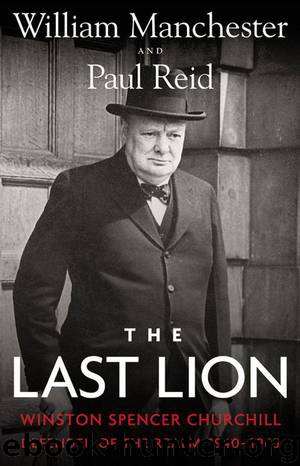The Last Lion: Defender of the Realm, 1940-1965 by William Manchester

Author:William Manchester [Manchester, William]
Language: eng
Format: epub
Tags: Europe, History, Great Britain, Biography & Autobiography, History / Europe - Great Britain, History / Military - World War Ii, World War II, Presidents & Heads of State, Biography & Autobiography / Presidents & Heads Of State, Military
ISBN: 9780316222143
Google: ebCoEp9z76sC
Publisher: Hachette Digital, Inc.
Published: 2012-11-06T08:00:00+00:00
With the vote of censure behind him and the decision made in favor of Torch, Churchill’s attention turned to Egypt, and Stalin. Based on Ultra decrypts, he had prodded Auchinleck for weeks to take the offensive against Rommel, unfairly in Brooke’s estimation. Ultra allowed Churchill to peer over his generals’ shoulders as if he were with them in the field poring over intelligence reports. Yet Ultra was sometimes wrong. Churchill took Rommel’s (decrypted) pleas for reinforcements at face value, while some at Bletchley cautioned that Rommel might be exaggerating his needs in order to force action in Berlin. On one occasion Churchill goaded Auchinleck by citing a decrypted Luftwaffe signal that appeared to reveal the Germans had only half as many tanks in Africa as Auchinleck believed based on his field intelligence. But Bletchley was incorrect; the deciphered message referred only to the German tanks at Auchinleck’s immediate front. Rommel, after taking several necessarily desultory and ultimately futile cracks at Auchinleck’s El Alamein positions during the first weeks of July, settled into a defensive mode and awaited his promised reinforcements. For his June victory over Ritchie, he was awarded by Hitler a field marshal’s baton. He would later say he would have preferred to be given a division. With Rommel dug in before El Alamein and with the fight possibly gone from Auchinleck, Churchill concluded that the situation in the desert called for his presence.279
His getting to Egypt involved doing so without contracting any of numerous diseases he would be exposed to along the way. In order for the aircraft to avoid Germans, the outbound leg of the journey would take at least five flying days, going south from Gibraltar to Takoradi, in the Gold Coast, followed by a three-day, three-flight hopscotch across central Africa. This sojourn through “tropical and malarious regions,” as Churchill put it, would require a series of inoculations, some of which required ten days to take effect. Dr. Wilson and the War Cabinet sought to put an end to the idea. Just that week, news of a great medical discovery had sifted through the ranks. Two American doctors visiting London from Johns Hopkins University had told Harry Butcher over a few bottles of port of a new drug “called penicillin and derived from bread mold. Takes eleven acres of mold to cure the scorched face of one flyer.” Such a drug would have made Churchill’s trip safer, but it had yet to be mass-produced. Given the risks posed by African insects and German fighter planes, it appeared that Churchill would not be straying far from London.280
Then an American pilot, Captain William Vanderkloot, twenty-six years old and a veteran of ferrying Lend-Lease bombers to Britain, suggested a daring approach: depart England for Gibraltar late in the evening by a four-engine B-24 bomber and refuel in Gibraltar the following morning; then, after departing the Rock at dusk, overfly Spanish Morocco, dodge far south over the desert during the night, and then swing east almost 1,900 miles to the Nile, south of Cairo.
Download
This site does not store any files on its server. We only index and link to content provided by other sites. Please contact the content providers to delete copyright contents if any and email us, we'll remove relevant links or contents immediately.
| Afghan & Iraq Wars | American Civil War |
| American Revolution | Vietnam War |
| World War I | World War II |
Waking Up in Heaven: A True Story of Brokenness, Heaven, and Life Again by McVea Crystal & Tresniowski Alex(37678)
Empire of the Sikhs by Patwant Singh(22983)
We're Going to Need More Wine by Gabrielle Union(18975)
Hans Sturm: A Soldier's Odyssey on the Eastern Front by Gordon Williamson(18491)
Leonardo da Vinci by Walter Isaacson(13190)
The Radium Girls by Kate Moore(11935)
Tools of Titans by Timothy Ferriss(8230)
Educated by Tara Westover(7948)
How to Be a Bawse: A Guide to Conquering Life by Lilly Singh(7397)
Permanent Record by Edward Snowden(5751)
The Last Black Unicorn by Tiffany Haddish(5563)
The Rise and Fall of Senator Joe McCarthy by James Cross Giblin(5234)
Promise Me, Dad by Joe Biden(5090)
The Wind in My Hair by Masih Alinejad(5036)
A Higher Loyalty: Truth, Lies, and Leadership by James Comey(4852)
The Crown by Robert Lacey(4732)
The Iron Duke by The Iron Duke(4295)
Joan of Arc by Mary Gordon(4024)
Stalin by Stephen Kotkin(3885)
